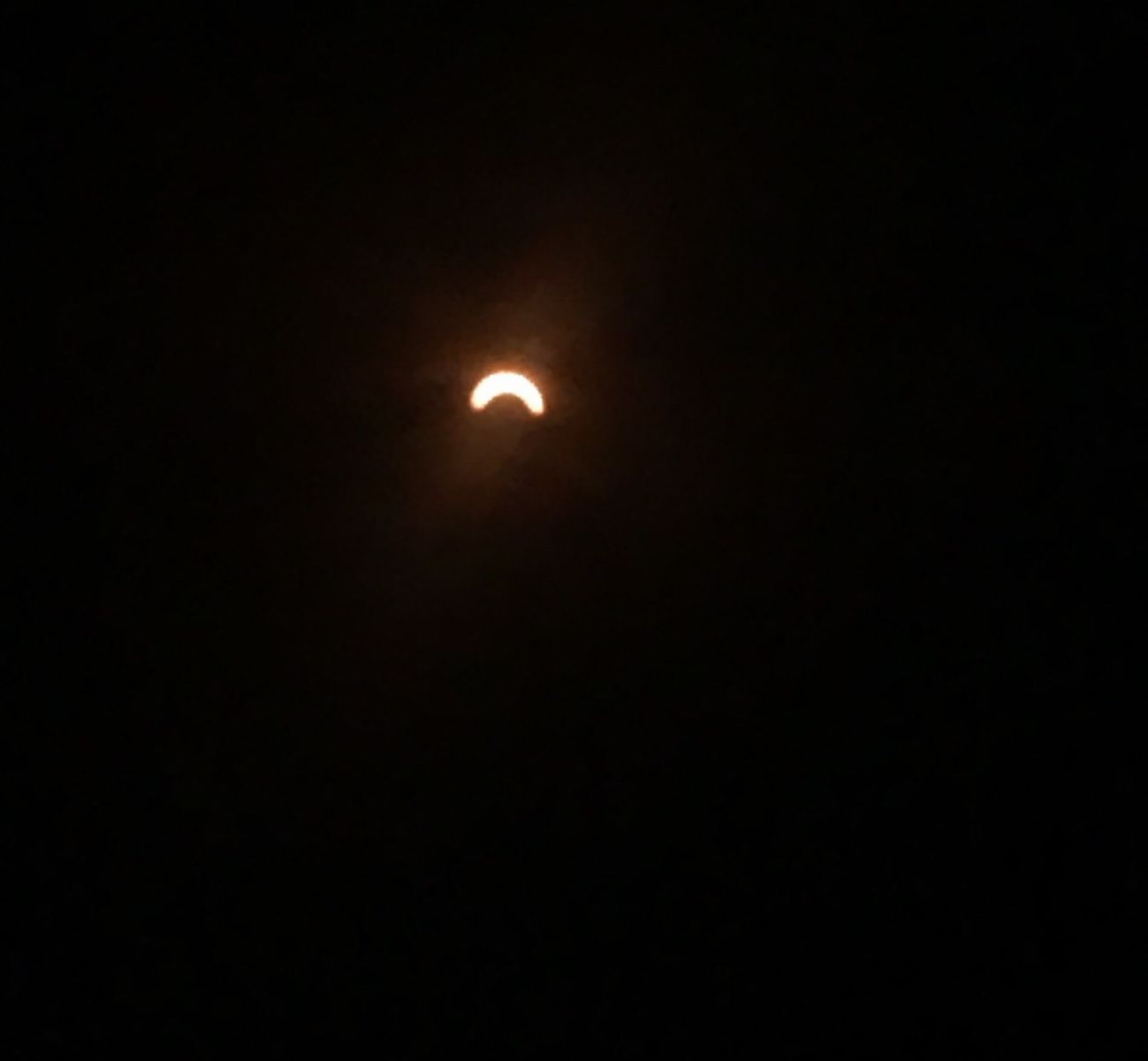It’s a Monday, and often in the social media world, the hashtag, “#MCM”, means someone is celebrating their Man Crush Monday. Well, here at NEED, we’re still reeling from last Monday’s eclipse events, so our #MCM is devoted to the cool view the moon gave us at this time last week. We’re calling this blog – Moon Crush Monday!
We know there were a million articles, news stories, and planning tips circulating for viewing the eclipse of 2017. Many of our newsfeeds and inboxes were filled with pics, stories, and (of course) the questions about where to get the glasses. And, now that we’ve all had a few days to process it, we thought we’d share a little bit about what WE did at NEED (scroll down for pics!), and share some classroom connections that you might be able to bring in as your school year gets started. And, if you’ve already started your school year – please share with us how you celebrated and observed this awesome occasion with your students. And heck, it’s not too early to start planning for 2024, right?
Connecting the Dots
Many schools across the country were in session during the eclipse, while others were not yet in session or had the day off. If you have yet to discuss the eclipse in your classroom, it can make a very fun class discussion for any day! Ask your students to describe their observations from the eclipse, or show a quick video clip and ask students to explain why they think an eclipse occurs. Take an opportunity to talk about sun safety – why we shouldn’t look at the sun, and why we should wear protection from it when we’re outdoors. And, of course, we can talk about the energy of the sun- the Great American Eclipse is a great attention grabber for the start of your energy unit.
NEED’s HOT solar energy suite of guides and activities is great for getting your students thinking about the sun and its energy. This unit has wonderful connections to Life, Earth, and Physical Science concepts while teaching about how we harness energy from the Sun. For an added twist, ask your students to compare the solar activity results on a normal, sunny day to eclipse day. How might their results differ if they repeated the process during the eclipse?
When thinking of solar energy, a major concern might be how the eclipse affects solar energy collection. As this eclipse traversed North America from west to east, it allowed all of North America to see the eclipse to some extent. However, many of these areas rely on solar energy during daytime hours in August. As the sun is slowly blocked out by the moon, we see it get darker, and solar panels slow their production of electricity. While the totality only lasts a few minutes, the sun is partially blocked for more than an hour during peak electricity demand times in the U.S. Check out this cool animated map of solar generation as the eclipse progressed. In fact, many utilities needed to work together with the North American Electric Reliability Corporation. While the NAERC didn’t predict a major disruption, local utilities needed to plan ahead and make sure additional generation sources were available to fill in for solar power that wasn’t being produced. As predicted, demand during this time declined somewhat because so many Americans took to the outdoors to watch the eclipse, however, some supplemental power was needed. States like California and North Carolina, who generate a large portion of their electricity from solar energy relied mostly on natural gas and concerted efficiency and conservation measures in the times when solar energy was declining. Utilities in California communicated with their customers through smart metering and app-based programs, encouraging customers to be mindful of their consumption during peak hours, thus reducing the need for supplemental generation sources. This concept of demand side management (DSM), proves helpful at many times throughout the year. These efficiency and conservation measures are often easy to employ, much like those found in NEED’s efficiency and conservation curriculum.
Solar energy provides nearly 42,000 MW of electricity in the U.S. currently, and is on the rise. How will utilities need to prepare for the eclipse of 2024, if solar power is expected to grow as an electric provider? What will they use to supplement during decreased production and how will they choose the source? Students can explore how utilities balance demand and generation by playing NEED’s Baseload Balance activity, found in NEED’s Coal Unit. For an added twist, incorporate an “incident card” that outlines an eclipse blocking sunlight during peak hours.
Outside of NEED curriculum, there are several awesome eclipse activities available from NASA, some can even be done any time during the year! The eclipse of 2024 will be moving through the country from Texas to Maine. Again, most of the country will be able to at least see a partial eclipse. And, this time, it’s on a Monday in April – a perfect teachable moment for your students. So, have a look now – plenty of time to test these fun activities out for yourself! Did your state experience totality, and will it during the next eclipse? When was the last time your state did experience a total eclipse? Find out here!
Odd Eclipse Occurrences
For many Americans, viewing this eclipse was a first-time occurrence. And, just like full moons tend to bring out the “odd” in our students, you might have noticed some odd things during the eclipse. NEED’s curriculum team learned and observed a few interesting things worth sharing. Did you take a second to observe your environment? What did you notice during the eclipse?
- During an eclipse, the gravitational force of the moon and sun together cause a tide in the body of the Earth. The Earth’s surface can bulge upward up to 40mm at the time of the eclipse, across a 1000 km area! That means, at some viewing locations, you actually got closer to the sun during the eclipse than you were a few hours before and after! (NASA)
- Going on a diet? Weighing yourself during the eclipse is a great time to do so. Due to the gravitational forces of the Earth, Moon, and Sun, and because of the centrifugal force we feel from rotating, at the time of the eclipse we’re actually about 1.7 ounces lighter! (NASA)
- During the eclipse the darkness we experience causes temperatures to drop, due to the decrease in radiation (radiant heating). In just 2-3 minutes, temperatures dropped on average of 5 degrees, the National Weather Service recorded one of the largest temperature changes in Douglas, WY, where the temperature dropped by 11 degrees from start to totality! (NWS)
- Populations swelled! Because the path of totality was within a short drive for many Americans, many town populations swelled to accommodate visitors. In Madras, Oregon, for example, the town reportedly jumped from 7,000 residents to 100,000 people during the eclipse. The National Guard was called in to help with crowd management! And, in Hopkinsville, TN, citizens reported a shortage of toilet paper and many other grocery essentials, as the town’s population supported many more visitors than expected. In South Carolina, the government prepared for an influx of 1 million visitors to the state, causing local governments to alter traffic patterns and close bridges during the eclipse.
- Animals got confused! Many wildlife experts were using this eclipse as an opportunity to observe animal behavior. We know that when we experience dusk, our solar-powered street lights come on, and many experienced this during the eclipse. But, those dusk-related animal behaviors also occurred in some places. On the app iNaturalist (www.inaturalist.org) zoos and other organizations were looking for folks to catalog animal behaviors as the eclipse progressed. Folks reported birds retreating to their trees, geese heading to the water, crickets and cicadas chirping, flowers opening and closing, and evening bugs appearing as totality approached. A few folks tweeted videos of roosters crowing as the sun re-appeared, birds beginning their calls in the morning, and strange zoo animal behavior, like giraffes running in circles! Did you notice anything cool?
NEED Staff Knows How to Party
Several NEED Staff members took the opportunity to view the eclipse in a fun way. TAB member and facilitator Don, watched with his family as the eclipse begin in Oregon. A few of our Kentucky Coordinators live on the path of totality in Western KY, including Sue, who experimented with Solar Beads during the eclipse. (check out her blog here.)
Our curriculum team hit the road to explore and view with their families. Caryn and her family headed to Springfield, TN, also in the path of totality. Caryn also happens to be an excellent photographer! She used a Canon ios Rebel with a 75-200mm lens. Her lens was at maximum zoom to take some of these AWESOME pics. Check out more here!
Emily headed to historic Charleston, SC, to watch the eclipse as it exited the continent. She and 1,000 other people took in the sights from the Boone Plantation in Mt. Pleasant, just outside the city. Clouds started to roll in as totality approached, but luckily the clouds parted just in time for the main event! Emily used a telephoto lens attachment for her phone, but clouds tried to mess with her focus! In the totality picture, you really must focus to see the corona ring amongst the clouds. It was hard to capture with the autofocus on the iPhone camera but much easier to see with your eyes. There was a heat index of 100 degrees that day, but they noticed a definite cooling effect as the sun departed temporarily for totality. That was the best 1 minute and 37 seconds! Check out the difference in light before and during the eclipse!


.jpg)
And, NEED HQ in Northern VA had a fun tie-dye party as they eagerly awaited the partial eclipse view that peaked at 2:42 pm EDT, as the moon obscured 82% of the sun.



Did you take your own pictures? Google and UC Berkeley teamed up to make an Eclipse Mega Movie, showing the eclipse continuously from coast to coast. Upload your pics and add them to help complete the movie, or check it out to share with your classroom! https://eclipsemega.movie/ And, as always, you can use NASA’s Eclipse Live site for photos and videos from the day to use as you teach about eclipses and solar energy in your classroom.
